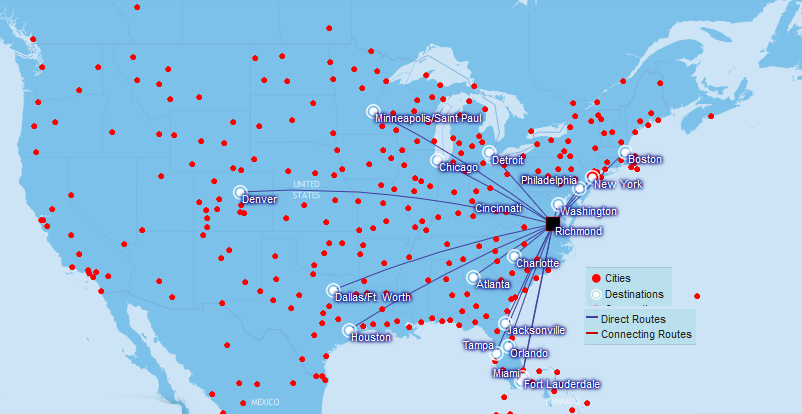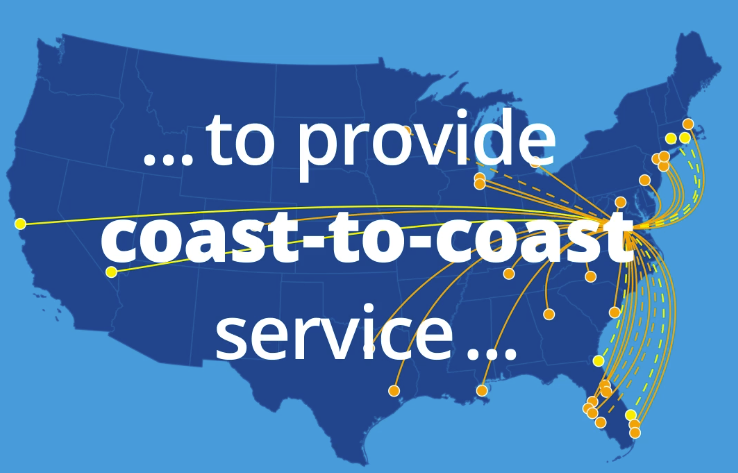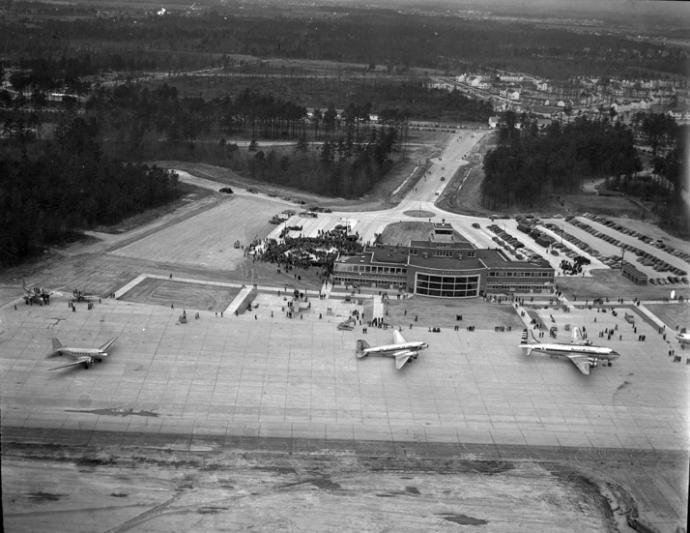
the 1950 terminal at the Richmond airport, seen here in a 1959 postcard, served until its first major expansion in 1968
Source: Virginia Commonwealth University, Terminal Building, Richard E. Byrd Airport, Richmond, Virginia

the 1950 terminal at the Richmond airport, seen here in a 1959 postcard, served until its first major expansion in 1968
Source: Virginia Commonwealth University, Terminal Building, Richard E. Byrd Airport, Richmond, Virginia
The first flights at the site of the Richmond International Airport (RIC) were during the Civil War. Union and Confederate armies used balloons for reconnaissance and to direct artillery fire.1

the first air operations in Richmond/Hampton Roads occurred with the inflation of the balloon Intrepid to reconnoiter the Battle of Fair Oaks (1862)
Source: Library of Congress, Professor Lowe's military balloon near Gaines Mill, Virginia
Byrd Airport was built in 1927. Other airports that opened in 1927 include Midway Airport (MDW) in Chicago, Hobby Airport (HOU) in Houston, and Piedmont Triad International Airport (PTI) in Greensboro, North Carolina.
Richmond officials arranged for Pitcairn Aviation Company to manage the airport, which had two paved runways 2,000 feet long each. Pitcairn had been awarded the lucrative contract to fly mail on the New York-to-Atlanta route.
Professor Janet Bednarek has described the urgency for cities to open airports and be on the route of commercial airlines carrying the mail:2

Richmond International Airport (RIC) is located in Henrico County, east of the city limits of Richmond
Source: ESRI, ArcGIS Online
Charles Lindbergh attended the dedication on October 15, 1927, flying in with the Spirit of St. Louis four months after crossing the Atlantic Ocean. Eastern Airlines started flying from Richmond to New York in 1930, and began regularly scheduled flights from Byrd Field in 1932.3
The name honored Richard Evelyn Byrd, younger brother of Governor Harry Flood Byrd. Richard Byrd became famous after reporting a successful flight over the North Pole on May 9, 1926. Byrd and fellow pilot Floyd Bennet were in a race to reach the North Pole before a team led by rival Roald Amundsen. That team reached the "top of the world" in a dirigible, three days after Byrd and Bennet.
There were suspicions that Byrd and Bennet had not reached the North Pole on their almost 16-hour flight from Spitzbergen in Norway. The U.S. Navy and a committee of the National Geographic Society supported Byrd's claim, and the US Congress awarded both pilots the Medal of Honor.
Byrd's flight over the South Pole in 1929 is accepted without dispute. He had retired from the US Navy as an ensign in 1916 due to a broken foot, but the US Congress gave him political promotions. After flying over the South Pole, he was made a Rear Admiral in the US Navy.4
In 1927, the US Department of Commerce described conditions at "Richmond Municipal Airport" in September 1927, before the dedication. There wee two runways, each 3,000' long and 300' wide. The surface was sod, except that the middle 100' of each runway was gravel.5

Byrd Field in 1927
Source: Department of Commerce, Airway Bulletin No. 189 (1927)
Byrd Field was used as a military base in World War II and expanded significantly by the Army Air Corps. In 1942 the Federal government condemned private property so the 936th Camouflage Battalion could built a phony airfield four miles away. Duplicate runways and buildings were erected on the Elko Tract and partially concealed. The expectation was that an attempt at camouflage would convince German pilots who might reach Richmond that the fake site was the real airport.
The only pilot fooled by the deception was one who was lost in fog in 1950. He started to land at what he thought was Byrd Field. The pilot realized his mistake too late and died when the plane crashed into pine trees.
After World War II, the Federal government transferred 2,250 acres to the Commonwealth of Virginia. The state planned to build planned two hospitals for African Americans. It completed sewers and streets, but local opposition ended the project before the hospitals were built.
For generations, the "Lost City" was explored by teenagers, ghost hunters, and those looking for an isolated place for experiencing or adventure. Five decades later, Henrico County began to turn the Elko Tract into the White Oak Technology Park.6
Source: Henrico County, The Elko Files: History and Mystery in Eastern Henrico
A terminal building was dedicated at Byrd Field in 1950.

the terminal at Byrd Field opened in 1950
Source: Virginia Commonwealth University (VCU), Terminal Building, Richard E. Byrd Airport, Richmond, Virginia

the terminal at Byrd Field
Source: Library of Virginia Visual Studies Collection, Byrd Airport terminal (Adolph B. Rice Studio, June 24, 1956)
Adoption of jet travel led to another major expansion in 1968. Terminals were upgraded in 1995, 2002, and again in 2007. Byrd Field was renamed Richmond International Airport (RIC) in 1984.7
The airport is located in Henrico County. It has been managed by the Capital Region Airport Commission since 1975. Commissioners are appointed from the City of Richmond and counties of Hanover, Henrico, and Chesterfield.8

in 2016, American Airlines, Delta Air Lines, JetBlue Airways, Southwest Airlines, United Airlines and Allegiant flew from Richmond International Airport to hubs where passengers could catch another flight to an international destination
Source: Richmond International Airport, Route Map for Richmond International Airport
The worst airplane crash at the airport occurred in 1946. A DC-3 operated by Viking Air Transport landed with engine problems. The pilots then took off to get to Atlanta ahead of bad weather, but immediately decided to return to Richmond when one engine malfunctioned.
On the second attempt to land, the pilot attempted to shut down the engine that was running rough. In a fatal mistake, he shut down the good engine instead of the malfunctioning one. The plane crashed about six miles south of Byrd Field, killing all 27 people on board.9

aeronautical chart for area including Richmond International Airport (RIC)
Source: SkyVector
The airport in Richmond competes with the Newport News/Williamsburg International Airport (PHF) for customers from the Peninsula. In 2020, airlines reduced operations at Newport News, but announced that direct flights from Richmond to Las Vegas and Los Angeles would be offered in 2021.10
Richmond won the competition during the COVID-19 pandemic. Commercial air travel declined and did not recover at Newport News/Williamsburg International Airport (PHF), but gradually climbed back at Richmond International Airport (RIC) from the low point of just 14,000 travelers in April 2020. There were 385,000 travelers in March 2023, close to the peak of 399,000 travelers in August 2019.11
In 2024, Richmond International Airport (RIC) set new records for traffic. It handled 4,884,093 passengers and 222,775,013 pounds of cargo volume. International flights restarted in 2025, a dozen years since the last such flights to Toronto ended, as BermudAir began flying to Bermuda.12

the airport added international flights to Bermuda in 2025, expanding beyond its coast-to-coast service
Source: Richmond International Airport, Airport Information

Byrd Field in the 1950's
Source: Library of Virginia Visual Studies Collection, Byrd Field (Adolph B. Rice Studio)